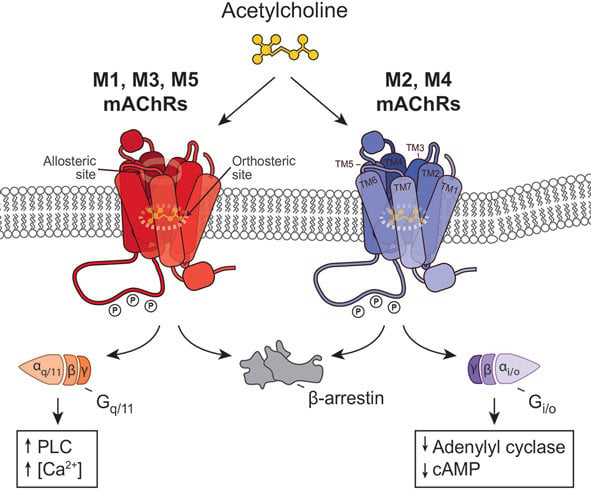-
Muscarinic antagonist
Procyclidine hydrochloride is a muscarinic antagonist that crosses the blood-brain barrier and is used in the treatment of drug-induced extrapyramidal disorders and in Parkinsonism. -
Muscarinic antagonist
Mepenzolate Bromide is a muscarinic antagonist used to treat gastrointestinal disorders. It decreases the severity of elastase-induced airspace enlargement and respiratory dysfunction. -
M1 muscarinic receptor antagonist
Pirenzepine dihydrochloride (LS519) is a selective M1 muscarinic receptor antagonist. - Pirmenol hydrochloride inhibits IK.ACh by blocking muscarinic receptors. The IC50 of Pirmenol for inhibition of Carbachol-induced IK.ACh is 0.1 μM.
-
mAChR antagonist
Atropine methyl bromide, a muscarinic receptor (mAChR) antagonist, is a quaternary ammonium salt of atropine and a mydriatic for dilation of the pupil during ophthalmic examination. It is introduced for relieving pyloric spasm in infants for its highly polar nature. It penetrates less readily into the central nervous system than atropine. -
mAChR agonist
Cevimeline (Evoxac) Hcl is a parasympathomimetic and muscarinic agonist, with particular effect on M3 receptors; used in the treatment of dry mouth associated with sjogren's syndrome. - Piperidolate hydrochloride is an antimuscarinic, Also a potential inhibitor of human glutathione transferase P1-1.
-
alpha-1 adrenergic receptors / mAChRs inhibitor
Anisodamine is an inhibitor of alpha-1 adrenergic receptors and mAChRs isolated from Chinese solanacea plant. -
mAChR inhibitor
Piperidolate is a tertiary amine antimuscarinic. It is similar to atropine. It is mainly used in the smooth muscle spasm of the gastrointestinal tract and inhibits intestinal cramp induced by acetylcholine in rats and dogs. -
mAChR antagonist
Cimetropium Bromide (DA-3177) is a mAChR antagonist for long-term treatment of irritable bowel syndrome. -
muscarinic agonist
Talsaclidine is a muscarinic agonist with preferential neuron-stimulating properties. Talsaclidine is a full agonist at the M1 subtype, and as a partial agonist at the M2 and M3 subtypes. - Dexetimide ((+)-Benzetimide) is a high-affinity muscarinic receptor antagonist and a potent and persistent anticholinergic agent used to treat neuroleptic-induced parkinsonism.
-
partial M1 agonist and M2/M3 antagonist
Alvameline (Lu25-109) is a partial M1 agonist and M2/M3 antagonist. -
mAChR M5 positive allosteric modulator
VU 0365114 is a mAChR M5 positive allosteric modulator, with an EC50 of 2.7 μM. -
M5 NAM
VU 6008667 is a selective negative allosteric modulator of M5 NAM with IC50s of 1.2 μM and 1.6 μM for human M5 and rat M5, respectively. High CNS penetration. -
hM3Dq agonist.
DREADD agonist 21 is a potent human muscarinic acetylcholine M3 receptors (hM3Dq) agonist(EC50=1.7 nM). -
Sigma-1 receptor agonist/muscarinic M1 agonist
Blarcamesine, also known as AVex-73 and AE-37, is a muscarinic M1 agonist potentially for the treatment of Alzheimer's disease. It is an ς receptor ligand. -
mAChR modulator
Rapacuronium bromide is an allosteric modulator of muscarinic acetylcholine receptor (mAChR). -
mAChR antagonist
mAChR-IN-1 hydrochloride is a potent muscarinic cholinergic receptor (mAChR) antagonist, with an IC50 of 17 nM. -
M3 muscarinic receptor antagonist
Tarafenacin D-tartrate (SVT-40776 D-tartrate) is a highly selective M3 muscarinic receptor antagonist (Ki= 0.19 nM), ~200 fold selectivity over M2 receptor. -
mAChR antagonist
mAChR-IN-1 is a potent muscarinic cholinergic receptor(mAChR) antagonist with IC50 of 17 nM. -
mAChR5 modulator
VU 0238429 is positive allosteric modulator of muscarinic acetylcholine receptor subtype 5 (mAChR5 or M5), with an EC50 of 1.16 μM. -
[3H](+)pentazocine binding inhibitor
Levetimide is a potent and stereoselective inhibitor of [3H](+)pentazocine binding, with a Ki of 2.2 nM. -
muscarinic antagonist
Aclidinium Bromide(LAS 34273; LAS-W 330) is a long-acting, inhaled muscarinic antagonist as a maintenance treatment for chronic obstructive pulmonary disease (COPD). -
mAChR M5 negative allosteric modulator
(Rac)-VU 6008667 is a selective negative allosteric modulator of muscarinic acetylcholine receptor subtype 5 (M5 NAM) (IC50=1.8 μM, pIC50= 5.75), has high CNS penetration. -
mAChR agonist
Oxotremorine M iodide is a potent and non-selective muscarinic acetylcholine receptor (mAChR) agonist. -
muscarinic acetylcholine receptor antagonist
Benzetimide hydrochloride is a muscarinic acetylcholine receptor antagonist. -
mAChR antagonist
Nor-benzetimide is a major metabolite of Benzetimide. Benzetimide is a mAChR antagonist with anticholinergic activity.
mAChR


Muscarinic acetylcholine receptors (mAChRs) are a class of G protein-coupled receptors (GPCRs) found in the central and peripheral nervous systems, as well as in various other tissues and organs throughout the body. These receptors are named after muscarine, a natural alkaloid compound found in certain mushrooms, which was one of the first substances discovered to activate them.
There are five subtypes of muscarinic receptors, designated as M1 through M5, each with distinct tissue distribution and functions. Here's an overview of their roles:
- M1 Receptors: Predominantly found in the central nervous system, particularly in regions associated with cognitive functions. Activation of M1 receptors is linked to memory and learning.
- M2 Receptors: Found in the heart, where they play a crucial role in regulating heart rate and cardiac contractility. Activation of M2 receptors slows heart rate and reduces the force of cardiac contractions.
- M3 Receptors: Present in smooth muscle tissues, such as those in the gastrointestinal tract, urinary bladder, and bronchial airways. Activation of M3 receptors leads to smooth muscle contraction.
- M4 Receptors: Distributed mainly in the central nervous system and involved in modulating neurotransmitter release. Their role in cognition and neuropsychiatric disorders is of interest.
- M5 Receptors: Located in certain areas of the brain and implicated in the modulation of dopamine release. Research suggests they may be relevant to Parkinson's disease and addiction.
Muscarinic receptors are activated by the neurotransmitter acetylcholine and play a vital role in regulating a wide range of physiological processes, including heart rate, smooth muscle contraction, glandular secretion, and neurotransmitter release. They are targets for various drugs, including anticholinergic agents, which block their activity, and drugs used to treat conditions like bradycardia and neurodegenerative disorders.
Understanding the functions and regulation of muscarinic acetylcholine receptors is essential for developing therapies that modulate their activity and for advancing our knowledge of how they contribute to various physiological and pathological processes in the body.








